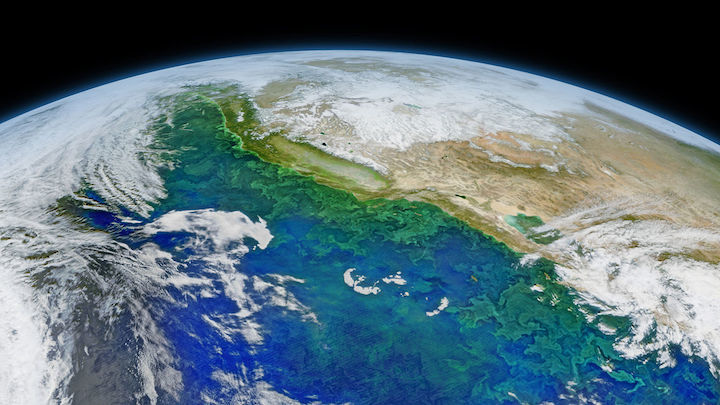17.09.2020

Never underestimate pond scum. The asteroid impact that killed most of the dinosaurs 66 million years ago also created conditions for ocean microbes to flourish, according to a new study. In microscopic rock crystals, researchers have found evidence that massive blooms of algae and photosynthetic bacteria covered the world’s oceans, providing food for larger marine creatures soon after the cataclysm.
In 2016, researchers working in the Gulf of Mexico drilled into the Chicxulub crater, the scar left behind by the asteroid impact, buried under the sea floor. They found that sediments deposited immediately after the impact were rich in micrite, a calcium carbonate mineral. Calcium carbonate, common in limestone, precipitates in the world’s oceans: Corals and plankton build skeletons of it, microbes such as bacteria produce it, and it can even form directly from seawater.
The discovery was a déjà vu moment for Timothy Bralower, a marine geologist at Pennsylvania State University, University Park. In 2001, Bralower and his colleagues had spotted micrite in rocks from the western Pacific Ocean that dated to the time of the impact. “When we saw this micrite layer in the crater, we went ‘bingo,’” Bralower says. “We’ve seen this before.”
In fact, rocks collected from 31 sites around the world contain a layer of micrite that’s 66 million years old, Bralower realized when he pored over his extensive collection of rock samples mounted on microscope slides. “We see it all over the oceans,” he says.
To understand how the micrite formed, Bralower and his colleagues zoomed in on the minerals using electron microscopes. They found that its crystals were often composed of even smaller microcrystals shaped like six-sided rhombohedra or scalenohedra with more than eight sides. Previous researchers didn’t see these structures because they weren’t zooming in enough, Bralower says. “People have looked at it before, but not with enough magnification.”
The microcrystals are remarkably similar to the calcium carbonate produced by modern-day bacteria, and so most of the micrite is likely biological in origin, Bralower and his colleagues report in Earth and Planetary Science Letters. The life that created this micrite was probably part a “survivor microbial community” that emerged in the aftermath of the impact, the researchers suggest.
In addition to wiping out so much life on land, the impact decimated ocean ecosystems as well. Vaporized rock led to a buildup of sulfuric acid that rained down on oceans along with toxic metals like lead and mercury. More than 90% of marine phytoplankton went extinct, researchers have shown.
Yet that destruction also paved the way for newcomers, says Julio Sepúlveda, a biogeochemist at the University of Colorado, Boulder, who was not involved in the research. “If you wipe out an important group from an ecosystem, you have an empty ecological niche.”
Those newcomers, other algae and photosynthetic bacteria, were “ready to take over the world,” Bralower says. As they proliferated in oceanwide blooms, they would have acted as a food source themselves for animals higher up the food chain like krill and shrimp, Bralower and his colleagues propose. And they left behind evidence of their existence in the form of micrite.
It’s worth digging further into the past to scan for similar blooms after other mass extinctions, the researchers suggest. Looking at the Permian extinction 252 million years ago, a whopper that killed off more than 90% of the planet’s species, would be a good place to start, Bralower says. “I bet you if you looked at the end Permian you’d find these structures there as well.”
Quelle: AAAS
